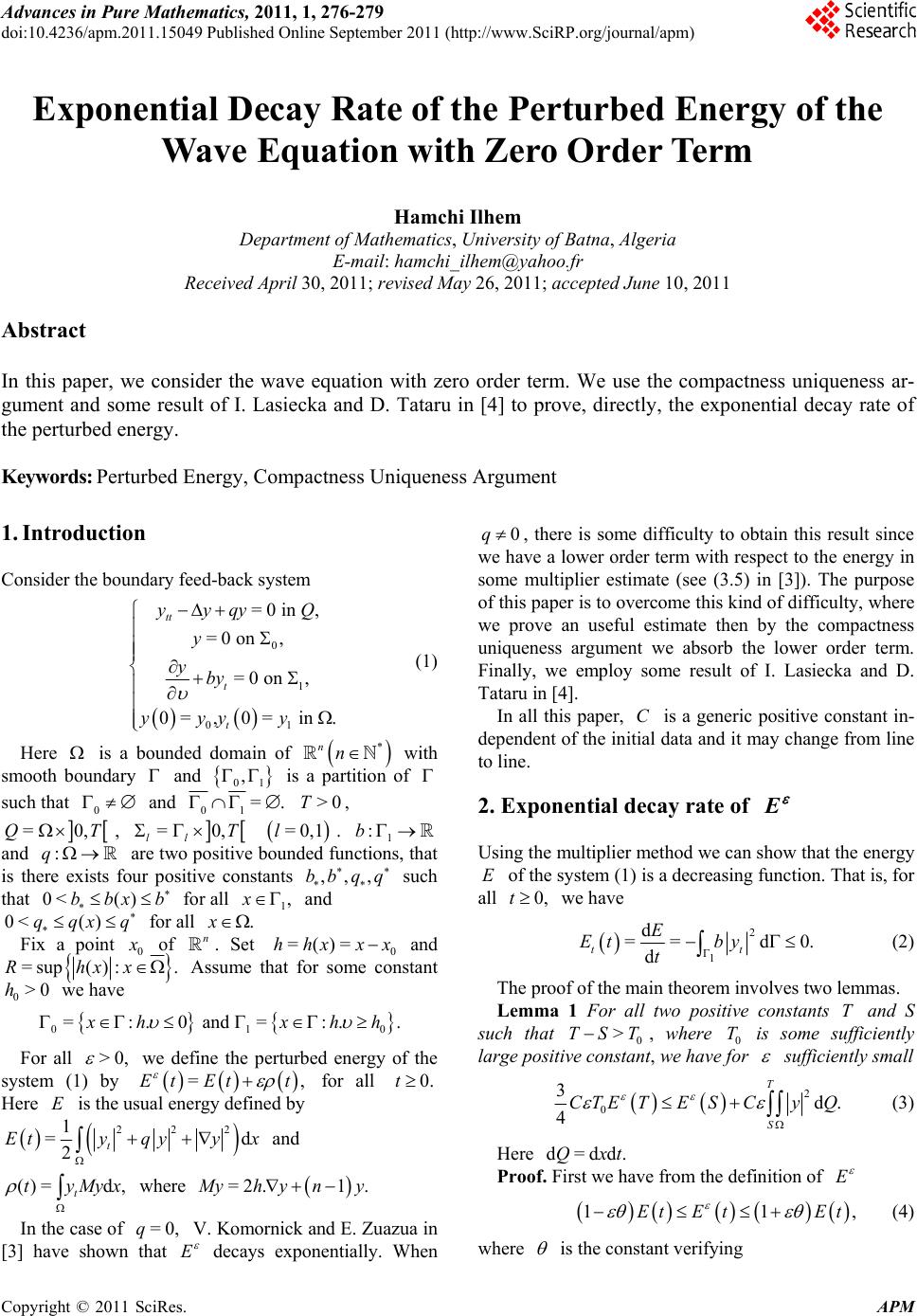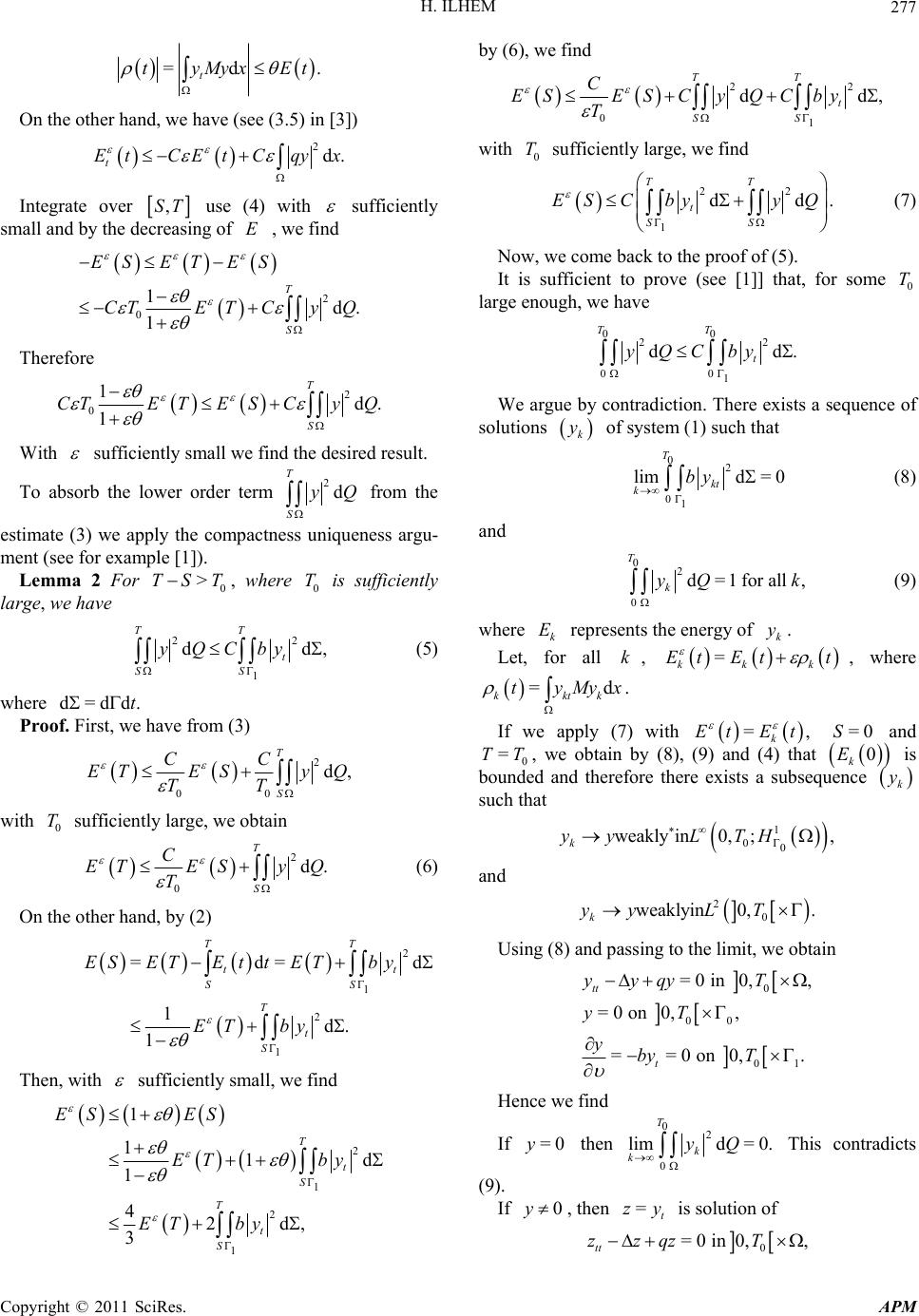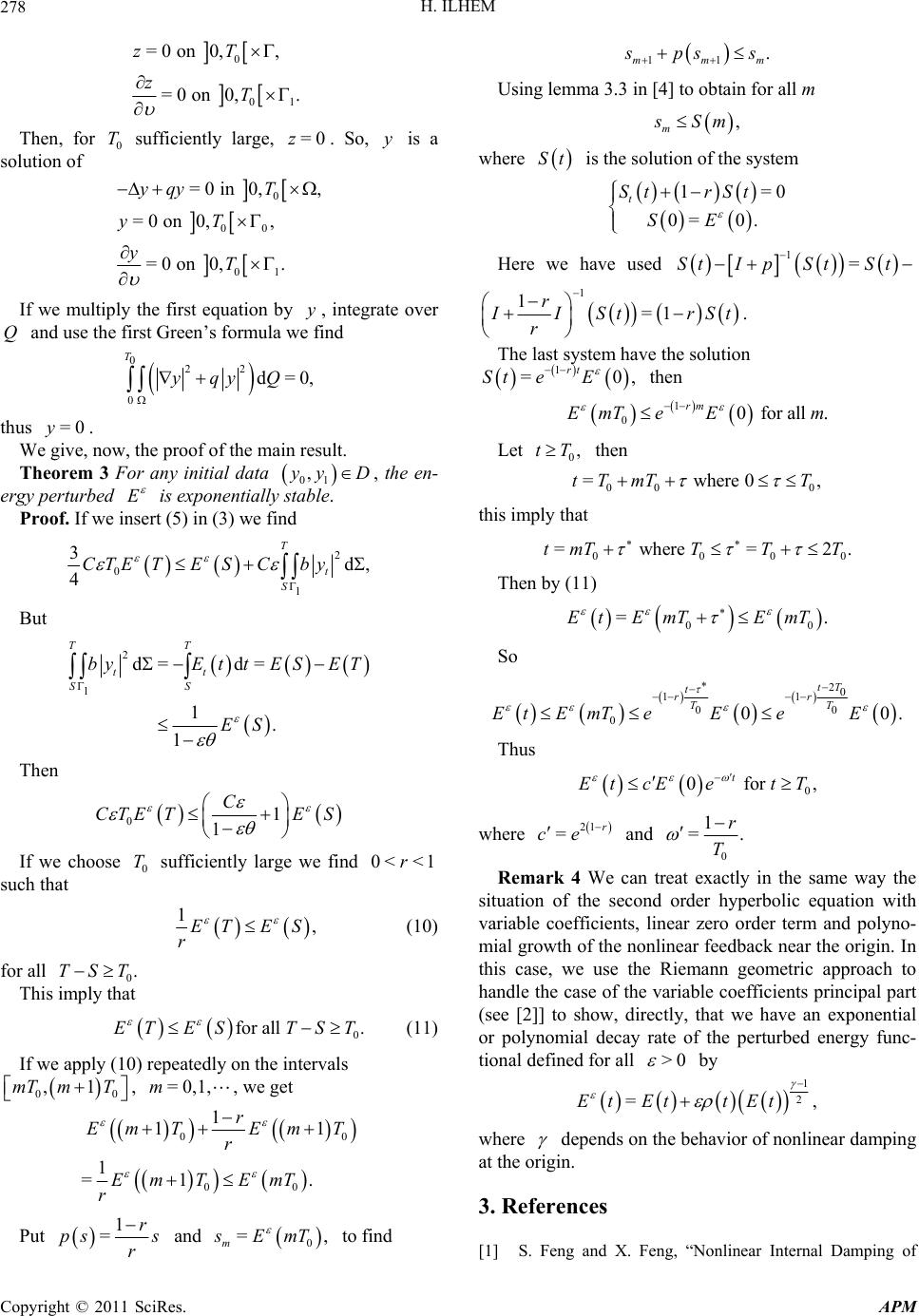 Advances in Pure Mathematics, 2011, 1, 276-279 doi:10.4236/apm.2011.15049 Published Online September 2011 (http://www.SciRP.org/journal/apm) Copyright © 2011 SciRes. APM Exponential Decay Rate of the Perturbed Energy of the Wave Equation with Zero Order Term Hamchi Ilhem Department of Mat hematics, University of Batna, Algeria E-mail: hamchi_ilhem@yahoo.fr Received April 30, 2011; revised May 26, 2011; accepted June 10, 2011 Abstract In this paper, we consider the wave equation with zero order term. We use the compactness uniqueness ar- gument and some result of I. Lasiecka and D. Tataru in [4] to prove, directly, the exponential decay rate of the perturbed energy. Keywords: Perturbed Energy, Compactness Uniqueness Argument 1. Introduction Consider the boundary feed-back system 0 1 01 =0 in , =0 on , =0 on , 0=,0= in . tt t t yyqy Q y yby yyy y (1) Here is a bounded domain of with smooth boundary and is a partition of *nn 01 , such that and 0 01 =. , >0T =0,QT, =0, ll T . 1 =0,1l:b ,qq and are two positiv e bounded fu nctions, that is there exists four positive constants such that for all and for all :q 0<bb 0<( )qq x ,,bb 1,( )xb x q .x Fix a point 0 of n . Set 0 =()=xxhhx and =sup():.Rhx x Assume that for some constant we have 0>0h 01 =:.0 and =:. 0 . hxh h For all >0, we define the perturbed energy of the system (1) by for all Here is the usual energy defined by =,Et Ett 0.t E 222 1 =d 2t Etyqyy x and ()= d, t tyMyx where =2 .1. yhyny In the ca se of V. Komornick and E. Zuazua in [3] have shown that =0,qE decays exponentially. When 0q , there is some difficulty to obtain this result since we have a lower order term with respect to the energy in some multiplier estimate (see (3.5) in [3]). The purpose of this paper is to overcome this kind of difficulty, where we prove an useful estimate then by the compactness uniqueness argument we absorb the lower order term. Finally, we employ some result of I. Lasiecka and D. Tataru in [4]. In all this paper, is a generic positive constant in- dependent of the initial data and it may change from line to line. C 2. Exponential decay rate of Using the multiplier method we can show that the energy of the system (1) is a decreasing function. That is, for all we have Et0, 2 1 d == d0. d tt E Et by t (2) The proof of the main theorem involves two lemmas. Lemma 1 For all two positive constants and S such that 0 T >TST , where 0 is some sufficiently large positive constant, we have for T sufficiently small 2 0 3d. 4 T S CTE TESCyQ (3) Here d=dd.Qxt Proof. First we have from the definition of E 11EtE tEt , (4) where is the constant verifying  H. ILHEM277 =d t tyMyxEt . On the other hand , we have (s ee (3.5) in [3]) 2d. t EtCEtCqy x Integrate over ,ST use (4) with sufficiently small and by the decreasing of , we find E 2 01d. 1 T S ESETES CTE TCyQ Therefore 2 01d. 1 T S CTE TESCyQ With sufficiently small we find the desired result. To absorb the lower order term 2d T S yQ from the estimate (3) we apply the compactness uniqueness argu- ment (see for example [1]). Lemma 2 For , where is sufficiently large, we have 0 >TST0 T 22 1 d TT t SS yQCby d, (5) where d=dd.t Proof. First, we have from (3) 2 00 d, T S CC ETESy Q TT with sufficiently large, we obtain 0 T 2 0 d. T S C ETESy Q T (6) On the other hand , by (2) 2 1 2 1 =d= 1d. 1 TT tt SS T t S ESETE ttETby ET by d Then, with sufficiently small, we find 2 1 2 1 1 11d 1 42d, 3 T t S T t S ES ES ET by ET by by (6), we find 22 01 dd TT t SS C ESESCy QCby T , with sufficiently large, we find 0 T 22 1 dd TT t SS ESCbyy Q . (7) Now, we come back to the proof of (5). It is sufficient to prove (see [1]] that, for some large enoug h, we have 0 T 00 22 00 1 dd TT t yQCby . We argue by contradiction. There exists a sequence of solutions k of system (1) such that 02 01 limd= 0 T kt kby (8) and 02 0 d=1 for all , T k yQ k (9) where represents the energy of . k Ek y Let, for all , k = kk k Et Ett , where =d kkt tyMy k x . If we apply (7) with and 0, we obtain by (8), (9) and (4) that =, k Et Et =0S =TT 0 k E is bounded and therefore there exists a subsequence k such that 1 00 weakly in0,;, k yy LTH and 20 weaklyin 0,. k yy LT Using (8) and passing to the limit, we obtain 0 00 01 =0 in 0,, =0 on 0,, ==0 on 0,. tt t yyqyT yT yby T Hence we find If then =0y02 0 limd=0. T k kyQ This contradicts (9). If 0y , then is solution of =t zy 0 =0 in0,, tt zzqzT Copyright © 2011 SciRes. APM  H. ILHEM 278 0 01 =0 on 0,, =0 on 0,. zT zT Then, for sufficiently large, . So, is a solution of 0 T=0zy 0 00 01 =0 in 0,, =0 on 0,, =0 on 0,. yqy T yT yT If we multiply the first equation by , integrate over and use the first Green’s formula we find y Q 022 0 d=0, T yqyQ thus . =0y We give, now, the proof of the main result. Theorem 3 For any initial data 01 , yD, the en- ergy perturbed E is exponentially stable. Proof. If we insert (5) in (3) we find 2 0 1 3d, 4 T t S CTE TESCby But 2 1 d= d= 1. 1 TT tt SS byEttE SET ES Then 01 1 C CTE TES If we choose sufficiently large we find such that 0 T0< <1r 1,ET ES r (10) for all 0 This imply that .TST 0 for all .ET ESTST (11) If we apply (10) repeatedly on the intervals , , we get 00 ,1mT mT =0,1,m 0 00 0 11 1 =1 . r Em TEmT r Em TEmT r 1 Put 1 =r ps s r and 0 = m 11 . mmm ps s Using lemma 3.3 in [4] to obtain for all m , m Sm where St is the solution of the system 1= 0= 0. t St rSt SE 0 Here we have used 1=StI pStSt 1 1=1 r ISt r , 0 rSt. The last system have the solution then 1 =0 rt St eE 1 00 for all . rm EmT eEm Let then 0,tT 00 = where 0,tT mTT 0 this imply that 000 = where =2.tmTT T T Then by (11) 00 =.Et EmTEmT So 20 11 00 000 tT t rr TT Et EmTeEeE . Thus 0 0 for , t Et cEetT 21 = cer and 0 1 =. r T where Remark 4 We can treat exactly in the same way the situation of the second order hyperbolic equation with variable coefficients, linear zero order term and polyno- mial growth of the nonlinear feedback near the origin. In this case, we use the Riemann geometric approach to handle the case of the variable coefficients principal part (see [2]] to show, directly, that we have an exponential or polynomial decay rate of the perturbed energy func- tional defined for all >0 by 1 2 =,Et EttEt where depends on the behavior of non linear d amping at the origin. 3. References , EmT to find [1] S. Feng and X. Feng, “Nonlinear Internal Damping of Copyright © 2011 SciRes. APM  H. ILHEM Copyright © 2011 SciRes. APM 279 Wave Equations with Variable Coefficients,” Acta Mathematica Sinica, Vol. 20, No. 6, 2004, pp. 1057-1072. doi:10.1007/s10114-004-0394-3 [2] Y. Guo and P. F. Yao, “Stabilization of Euler-Bernoulli Plate Equation with Variable Coefficients by Nonlinear Boundary Feedback,” Journal of Mathematical Analysis and Applications, Vol. 317, No. 1, 2006, pp. 50-70. doi:10.1016/j.jmaa.2005.12.006 [3] V. Komornick and E. Zuazua, “A Direct Method for Boundary Stabilization of the Wave Equation,” Journal de Mathématiques Pures et Appliquées, Vol. 69, 1990, pp. 33-54.
|